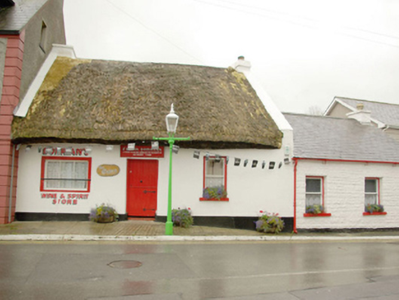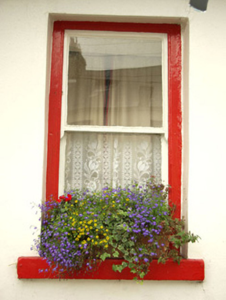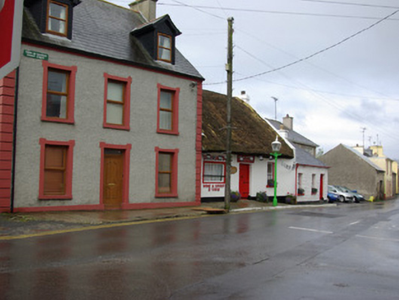Survey Data
Reg No
40852010
Rating
Regional
Categories of Special Interest
Architectural, Social, Technical
Previous Name
Frank Dorrian
Original Use
House
In Use As
Public house
Date
1830 - 1900
Coordinates
187560, 361684
Date Recorded
30/10/2007
Date Updated
--/--/--
Description
Attached (formerly end-of-terrace c. 1900) three-bay single-storey thatched public house, built c. 1850, having three-bay single-storey extension attached to the west. Formerly in use as a private dwelling. Pitched straw thatch roof with sally restraining rods to eaves, to eaves, ropework to ridge, and with raised render verges and rendered chimneystacks to gable ends (east and west). Corbel course to chimneystack to the west. Smooth rendered walls over smooth rendered plinth. Square-headed window openings with stone sills, and having timber one of over pane timber sliding sash window to the opening to the west end of the front elevation (north) and fixed three pane/tripartite timber shop display window to the east end of the main elevation having plain rendered surround and metal protection bar. Central square-headed door opening having stone plinth blocks to base, and timber battened half-doors with decorative wrought-iron hinges to bottom panel. Timber ‘licensing’ panel over doorway having moulded timber surround and painted lettering. Three-bay single-storey extension to the west with pitched natural slate roof with chimneystack to the west gable end, rendered walls with ‘rock-faced masonry’ effect, square-headed window openings with one-over-one pane timber sliding sash windows, square-headed doorway with timber door having metal hinges, and cast-iron rainwater goods. Road-fronted to the east end of Bishop Street, and to the north of Ballyshannon town centre. Courtyard to the rear with toilet block to the south.
Appraisal
This well-maintained thatched vernacular public house retains its early form and character. Its integrity is enhanced by the retention of a number of early fittings to the openings. The irregular spacing of the openings to the front façade lends it an appealing vernacular character that is typical of such buildings in Ireland. Modest in scale, it exhibits the simple and functional form of vernacular building in Ireland. Buildings of this type were once a ubiquitous feature of small Irish towns and villages, particularly in the outskirts along the approach roads to the centre, but are now becoming very rare making this an increasingly important survival. Of particular interest in the survival of the thatch roof, which is now sadly becoming increasingly rare in Donegal. The form of this building having chimneystacks to the gable ends suggests that this building is of the ‘direct entry’ type that is characteristic of the vernacular tradition in north-west Ireland. This building was probably originally built as a private house and later converted to a public house, and the fixed pane display window added, perhaps c. 1900. It was formerly end-of-terrace building (Ordnance Survey twenty-five inch map c. 1900) with the extension to the west a later addition, perhaps c. 1930). This colourful vernacular building is an important addition to the roadscape to the north end of Ballyshannon town centre, and is an integral element of the built heritage of the local area.















